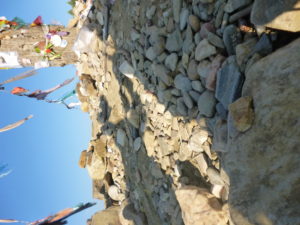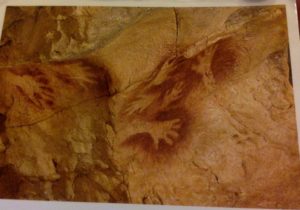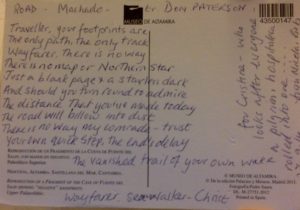


Post 3
“I had walked from Leon to Santiago in 2011, and that was a life changing experience for me. When I went in 2014, I was mainly aiming for some time for myself, to be back to synchrony with my own rythm and needs, a change from what my life had been the previous 2 years.
“My Camino experience until that day in the Albergue Guacelmo was not “as revealing” was I would had expected, or at least, that is what I thought. I was enjoying my time with my Camino family, several of them met in the first night in Orizzon, I was enjoying my walking time with my pilgrim friend from Canada, and I was enjoying the conversations with so many other pilgrims that while not walking with me daily or not being part of “my Camino Family”, were (are) part of my Camino. But I often times found myself that I was also “following” their times, their wishes, their plans for the day… not fully synchronized with my time, my wish or my plan for the day.
“That was a daily question: “how do I combine all the good and enjoyable and care that I get with them, with this need of me for time, for coming back to my rythm, to follow my wishes?” At the end of the day, wasn’t that why I left to the Camino? Wasn’t that why I did not have a book to follow or thought I would not be booking albergues?
“The Albergue Guacelmo was one of those albergues where you can only stay if you have walked with your backpack, the doors open at 11:30, as many other albergues, is run by volunteers and despite they have more beds, they only run it full if there is a massive flow of pilgrims, otherwise, they only take 35 pilgrims.
“The day I was there, the check in was lengthy, we were invited to sit one by one, as in an oral exam at university. The hospitaleros were a couple from South of England, the man took our information, and the woman was showing each of the pilgrims the rooms. Unbelievable, after one hour, they called us by our names and in the corridors or in the patio, they would make questions about our countries or our work or our family at home.
“When I set up the chairs in the patio to treat the blisters of the Irish Pilgrim, the hospitalero man gave me a look that I will never forget. Later, as the German lady wanted me to check her knee but language was a real barrier, the hospitalero woman came with a dictionary and tried to help with the translation. In the evening, the hospitalera already in pajamas, came to sit with me in the kitchen as I was waiting for the Young Pilgrim for his dinner, we chatted a bit about the Camino experience, they had walked the previous year.
“The following morning, the hospitalero man served as breakfast, he toasted the bread for each of us individually, so we could get fresh toasted warm bread. I couldn’t really believe their attention to the detail. She was greeting each pilgrim at the door, in pajamas and with a robe, with a handful of keys hanging from her neck –It reminded me the nuns at school!- and to each she was asking whether we had picked up all our belongings, our tooth brushes from the bathrooms, our lunches from the fridge, our walking sticks, and was sending off each pilgrim with a hug and a kiss, as if we were kids going off to school. The final blessing was a “Buen Camino, X” (X was our name). How could that be? She had met us less than 16 hours before…
“When it was my turn, she asked me to leave my bagpack and go with her to “the hospitaleros’s office”. It was a cluttered place with signs and books, and papers, a phone, a desk computer. She closed the door and handed me a post card. She recited the poem that she wrote on the back, and she wished me I could live those words as I walked the Camino and my own life. She said I should find a life I would be happy to live. I was crying, she was crying, she gave me a hug I won’t forget, and we left the room. There were some other pilgrims waiting for her to say good bye, I went back to the line, and when it was my turn, we hugged again, we took a picture, and I suddenly knew my Camino lesson was that one. That morning we walked to Cruz de Ferro, the stone I carried from home was full of a new meaning too.”
Cris
